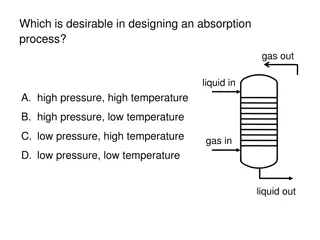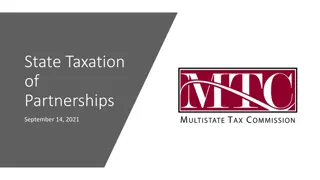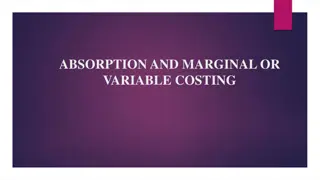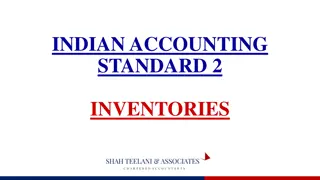Cost Allocation, Apportionment, and Absorption in Accounting
Cost allocation involves charging identifiable costs to specific cost centers or units, while cost apportionment distributes costs that cannot be directly identified among various departments. This process is crucial for managing overheads effectively in accounting practices. Dr. B. N. Shinde discusses these concepts in detail, highlighting the importance of accurately assigning costs to ensure financial accountability and efficiency.
Download Presentation

Please find below an Image/Link to download the presentation.
The content on the website is provided AS IS for your information and personal use only. It may not be sold, licensed, or shared on other websites without obtaining consent from the author. Download presentation by click this link. If you encounter any issues during the download, it is possible that the publisher has removed the file from their server.
E N D
Presentation Transcript
Cost Allocation, Apportionment and Absorption Presented by Dr. B. N. Shinde Assistant Professor Department of Commerce Deogiri College, Aurangabad
Cost Allocation When items of cost are identifiable directly with some products or departments such costs are charged to cost centres. This process is known as cost allocation. It is the charging of discrete, identifiable items of cost to cost centres or cost units. It is complete distribution of an item of overhead to the departments or products on logical or equitable basis is called allocation.
Cost Allocation Where a cost can be clearly identified with a cost centre or cost unit, then it can be allocated to that particular cost centre or unit. Allocation is the process by which cost items are charged directly to a cost unit or cost centre. Cost allocation calls for two basic factors Concerned department/product should have caused the cost to be incurred Exact amount of cost should be computable. Cost Allocation- Exam
Cost Allocation- Examples 5 Electricity charges can be allocated to various departments if separate meters are installed Depreciation of machinery can be allocated to various departments as the machines can be identified Salary of stores clerk can be allocated to stores department Cost of coal used in boiler can be directly allocated to boiler house division. Wages paid to workers of service department can be allocated to the particular department. Indirect materials used by a particular department can also be allocated to the department. Thus allocation is a direct process of identifying overheads to cost units or cost centres. So the term allocation means allotment of whole item of cost to a particular cost centre or cost object without any division.
Cost Apportionment 6 Cost Apportionment is the allotment of proportions of items to cost centers. When items of cost can not directly charge to or accurately identifiable with any cost centres, they are prorated or distributed amongst the predetermined basis. This method is known as cost apportionment. Wherever possible, the overheads are to be allocated. However, if it is not possible to charge the overheads to a particular cost centre or cost unit, they are to be apportioned to various departments on some suitable basis. This process is called as Apportionment of overheads. cost centres on some
Continue Items of indirect costs residual to the process of cost allocation are covered by cost apportionment. The predetermination of suitable basis of apportionment is very important and usually following principles are adopted- (i) Service or use (ii) Survey method (iii) Ability to bear.
Continue The predetermined and is decided after a careful study of relationships between the base and the other variables within the organisation. A lot of quantitative information has to be collected and constantly updated or periodically reviewed to improve upon the accuracy of apportionment. The basis selected should be applied consistently to avoid faults. The basis ultimately adopted should ensure an equitable share of common expenses for the cost centres In simple words, distribution of various items of overheads in portions to the departments or products on logical or equitable basis is called apportionment. basis for apportionment is normally
Continue Apportionment of overhead costs means to divide total cost of overhead among different departments or branches or cost centers of a company. We need the steps of apportionment of overhead costs when there are many departments or cost centers of any company because when we know the overhead cost of each department, we can find the total cost of department. With this, we can compare the revenue of each department with their total cost. Then take decisions relating to particular department.
Continue With this, we can compare the revenue of each department with their total cost. Then take decisions relating to particular department.
Continue Overheads common to all these departments Apportioned on some suitable basis Rent, rates & taxes Floor space occupied by each department , office, factory Repair to Plant or Department, Depreciation on office building Plant or Department's Value or any asset's Floor space occupied by each department For Legal fees No of cases handled as the basis For Salaries of common staff Ratio of salaries of departments as the basis For Typist pool No of documents typed as the basis For General Lighting and electricity No. of light points or Area or Units of Sub- meter in each Department For Telephones No. of extensions in a department For Material handling No. of material requisitions or Value of material issued Power H.P. Of Plant
Continue Supervision, Employer's liability No. of Employees Fire Insurance Value of Stock in any Department Indirect Labour Cost Total duty hours in any department Canteen Service Cost and other welfare expenses No. of Employees in Any Department Transport Cost No. of boxes or containers or weight of containers, hours of spending vehicle in any department
Example Total rent is Rs. 5000. Area of production department is A 100 Sq. foot. B 200 Sq. foot. C 700 Sq. foot. Now total ratio of A : B : C is 1 : 2 : 7 Total Rent Expense of A Department will be = 5000 X 1 /10 = Rs. 500 B Department will be = 5000 X 2 / 10 = Rs. 1000 C Department will be = 5000 X 7 / 10 = Rs. 3500 So, Total overhead cost will be apportioned to different department on some basis. Basis of Rent apportionment is the area of department
Cost Absorption The ultimate aim of Overhead Accounting is to absorb them in the product units produced by the firm. Thus, the indirect costs or overhead will have to be distributed over the final products so that the charge is complete. This process is known as cost absorption or Absorption of overheads
Continue It means costs is absorbed by the production (or product units )during the period or charging each unit of a product with an equitable share of overhead expenses. Usually any of the following methods are adopted for cost absorption- Direct Material Cost Percentage Direct Labour Cost Percentage Prime Cost Percentage Direct Labour Hour Rate Method Machine Hour Rate, etc.
Absorption of overheads Accurate absorption will help in arriving at accurate cost of production. Overheads are indirect costs and hence there are numerous difficulties in charging the overheads to the product units. .
Continue The basis should be selected after careful maximum accuracy of Cost Distribution to various production units. The basis should be reviewed periodically and corrective action whatever needed should be taken for improving upon the accuracy of the absorption

















































